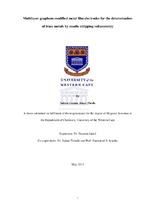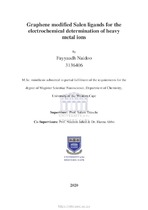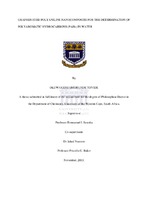| dc.description.abstract | In this study multilayer graphene nanosheets was synthesize by oxidizing graphite to graphene oxide using H2SO4 and KMnO4 followed by reduction of graphene oxide to graphene using NaBH4. The graphene nanosheets were characterized by Fourier Transform Infrared (FTIR) and Raman spectroscopy, high resolution transmission electron microscopy (HRTEM), Scanning electron microscopy (SEM) and X-ray diffraction (XRD). HRTEM images showed that the multilayer graphene were obtained. The graphene was immobilized directly onto a glassy carbon electrode using the drop coating technique followed by the in situ deposition of mercury, bismuth or antimony thin films to afford graphene modified glassy carbon metal film electrodes (Gr-GC-MEs). The experimental parameters (deposition potential, deposition time, rotation speed, frequency and amplitude) were optimized, and the applicability of the modified electrode was investigated
towards the individual and simultaneous determination of Zn2+, Cd2+ and Pb2+ at the low concentration levels (μg L-1) in 0.1 M acetate buffer (pH 4.6) using square wave anodic stripping voltammetry (SWASV). The detection limits values for the Gr-GC-HgE was 0.08, 0.05 and 0.14 μg L-1 for Zn2+, Cd2+ and Pb2+, respectively. The Gr-GC-BiE the detection limits for was 0.12, 0.22 and 0.28 μg L-1 for Zn2+, Cd2+ and Pb2+ while the detection limits for the Gr-GC-SbE was 0.1, 0.3 and 0.3 μg L-1 for Zn2+, Cd2+ and Pb2+, respectively. A Gr-GCE prepared without any binding agents or metal film had detection limits for Zn2+, Cd2+ and Pb2+ of 3.9, 0.8 and 0.2 μg L-1 for Zn2+, Cd2+ and Pb2+. Real sample analysis of which was laboratory tap water was performed using the Gr-GCMEs. Only Gr-GC-HgE was sensitive enough to detect metal ions in the tap water samples at the 3ppb level whereas, the GC-BiE and GC-SbE detected the metal ions at the 10 μg L-1 to
30 μg L-1 level. | en_US |



